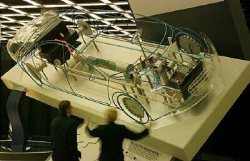| 
 Although
they are not expected to reach the mass market before 2010,
fuel cell vehicles (FCVs) may someday revolutionize on-road transportation.
This emerging technology has the
potential to significantly reduce energy use and harmful emissions,
as well as our dependence on foreign oil.
FCVs will have other benefits as
well. Although
they are not expected to reach the mass market before 2010,
fuel cell vehicles (FCVs) may someday revolutionize on-road transportation.
This emerging technology has the
potential to significantly reduce energy use and harmful emissions,
as well as our dependence on foreign oil.
FCVs will have other benefits as
well.
A Radical Departure
FCVs represent a radical departure from vehicles with conventional
internal combustion engines. Like battery-electric vehicles, FCVs
are propelled by electric motors.
But while battery electric vehicles use electricity from an external
source (and store it in a battery), FCVs create their own electricity.
Fuel cells onboard the vehicle create electricity through a chemical
process using hydrogen fuel and oxygen from the air.
FCVs can be fueled with pure hydrogen
gas stored onboard in high-pressure tanks. They also can be
fueled with hydrogen-rich fuels; such as methanol, natural gas,
or even gasoline; but these fuels must first be converted into hydrogen
gas by an onboard device called a "reformer."
FCVs fueled with pure hydrogen emit no pollutants; only water and
heat; while those using hydrogen-rich fuels and a reformer produce
only small amounts of air pollutants. In addition, FCVs can be twice
as efficient as similarly sized conventional vehicles and may also
incorporate other advanced technologies to increase efficiency.
top of page
Meeting Challenges Together
 Before
FCVs make it to your local auto dealer, significant research and
development is required to reduce
cost and improve performance. We must also find effective and
efficient ways to produce and store hydrogen and other fuels. Before
FCVs make it to your local auto dealer, significant research and
development is required to reduce
cost and improve performance. We must also find effective and
efficient ways to produce and store hydrogen and other fuels.
Automakers, fuel cell developers, component suppliers, government
agencies, and others are working hard to accelerate the introduction
of FCVs. Partnerships such as the DOE-led FreedomCAR
initiative and the California
Fuel Cell Partnership have been formed to encourage private
companies and government agencies to work together to move these
vehicles toward commercialization.
FreedomCAR
 FreedomCAR
is a new cooperative research effort between the DOE and the U.S.
Council for Automotive Research (Ford, General Motors, and DaimlerChrysler)
formed to promote research into advanced automotive technologies,
such as FCVs, that may dramatically reduce oil consumption and environmental
impacts. FreedomCAR's goal is the development of cars and trucks
that are: FreedomCAR
is a new cooperative research effort between the DOE and the U.S.
Council for Automotive Research (Ford, General Motors, and DaimlerChrysler)
formed to promote research into advanced automotive technologies,
such as FCVs, that may dramatically reduce oil consumption and environmental
impacts. FreedomCAR's goal is the development of cars and trucks
that are:
- Cheaper to operate
- Pollution-free
- Competitively priced
- Free from imported oil
California Fuel Cell Partnership (CaFCP)
The California
Fuel Cell Partnership is a collaboration
of auto companies, fuel providers, fuel cell technology companies,
and government agencies demonstrating fuel cell electric
vehicles in California under day-to-day driving conditions. The
goals of the partnership are to test and demonstrate the viability
of FCVs and related technology under real-world conditions, move
them toward commercialization, and increase public awareness. The
Partnership expects to place about 60 FCVs and fuel cell buses on
the road by 2003.
top of page
|